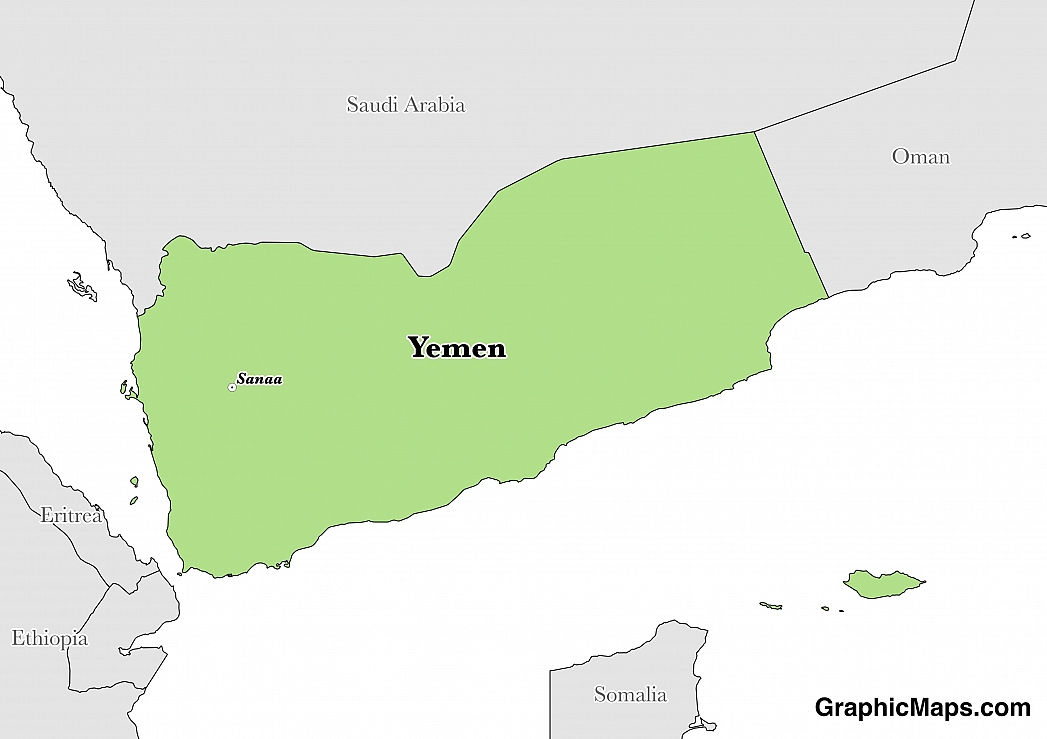Where is Yemen?
Located in the Middle East, Yemen has a 1,601.00 km border with Oman (294 km) and Saudi Arabia (1,307 km). It has a 1,906.00 km coastline. Saudi Arabia has reinforced its concrete-filled security barrier along sections of the fully demarcated border with Yemen.
The capital city of Yemen is Sana’a which is also the country’s most populated urban center. Declared as the nation’s official capital city by Yemen’s 1991 Constitution, Sana’a holds the distinction of being not only one of the oldest inhabited cities in the world but also one of the highest capitals. With a population of 3,937,451 Sana’a is divided into both Old and New Cities as well as being split into an array of administrative districts. The historic capital city’s Old City has been designated as a UNESCO World Heritage Site. Sana’a is a popular destination for tourists interested in exploring the city’s unique history and Arabic culture. Popular attractions in the urban center include the massive Al Saleh Mosque as well as the National Museum of Yemen. With its rare semi-arid climate Sana’a experiences its coldest temperatures in January with its hottest weather coming in July.
Read more on Yemen's CapitalYemen is an Asian country covering 527,968.00 km2. This makes it the 49th largest country in the world and almost four times the size of Alabama; slightly larger than twice the size of Wyoming. Its geographic coordinates are 15 00 N, 48 00 E and Sana'a is the capital city.
Its name may come from the Arab term for happiness, "yumn".
Its ISO code is YE.
Geography
Yemen has a mean elevation of 999 m above sea level.
The climate is tropical and heavily modified by altitude, with a rainy season from October to April. Its terrain consists mostly of narrow costal plains, backed by flat-topped hills and rugged mountains.
Population
Yemen has a population of 27,392,779 making it the 47th largest in the world. The majority of the population is found in the southern Sarawat Mounatins.
Arabic is the official language. The most common ethnic group is reported as Arab. The majority of the populaton identifies as Muslim.
Yemen’s only official language is Arabic which is a Central Semitic language. Although Modern Standard Arabic is the nation’s standard language a significant percentage of its residents use Yemeni Arabic during their day to day lives. Yemeni Arabic is considered to be a conservative and classical form of Arabic. Despite having no official status Yemeni Arabic is estimated to be spoken by over fifteen million people throughout the region. Common words in Arabic include the simple greeting of “hello” which can be translated to “marhaba” or “ahlan” and “na’am” meaning “yes”. A commonly heard phrase in Yemen, “Peace be with you” can be communicated using the Arabic words, “As-salam alaykum”. Yemen is home to a variety of unofficial minority languages including English, Russian, Cham, as well as several non-Arabic South Semitic languages including Mehri and Razihi.
Read more on Yemen's LanguagesThe dialing code for the country is 967.
Government
Yemen is an independent country. It was established as the Republic of Yemen in 1990. Its constitution was last ratified in 1991.
Yemen has a long and turbulent political history which is, in many ways still in flux today. Officially known as The Republic of Yemen, the nation currently operates under a transitional government. Since the unification of North and South Yemen the nation has been plagued by charges of corruption and internal political discord. Legislative affairs of state in Yemen are decided in the House of Representatives which is located in the capital city of Sana’a. The nation’s head of state, its President, lives in the Presidential (or Republican) Palace which is a heavily guarded compound which is not open to members of the public. The House of Representatives includes 301 members who each serve terms of six years.
Read more on Yemen's GovernmentEconomy
Factoring in Purchasing Power Parity, Yemen's GDP is $73,450,000,000.00 (USD) with $2,500.00 (USD) per capita. This makes it the 95th largest economy and its citizens the 192nd richest in the world. The currency of Yemen is the Rial (YER).
Its major export partners are China, the United Arab Emirates, and South Korea. Its main exports are crude oil, coffee, dried and salted fish, and liquefied natural gas. Its major import partners are the United Arab Emirates, Oman, and China. Its major imports include food and live animals, machinery and equipment, and chemicals.
Flag
The national flag of Yemen features three horizontal bands of color; red, white, and black. These are widely regarded to be traditional Pan-Arabic colors which symbolize unity among the various Arab states in the region. These colors also represent the blood spilled by Yemen’s martyrs over the course of its history, the nation’s bright future, as well as an acknowledgement of the darker days of its past. The official flag was adopted on May 22, 1990 after the unification of North and South Yemen. The inspiration behind the flag’s distinctive design came from the individual flags used by the northern and southern regions of Yemen. The design was also directly inspired by the Arab Liberation flag which was introduced after 1952. Throughout the years North and South Yemen flew a variety of flags including the solid red design used by the Mutawakkilite Kingdom of Yemen, the Federation of South Arabia’s design, as well as one which symbolized the People’s Democratic Republic of Yemen.
Read more on Yemen's FlagThis page was last modified on January 17th, 2018
More on Graphicmaps

Published on 2019-11-06
What is a Trade Embargo?

Published on 2019-11-04
Which Two Countries Used to Have the Same Flag?

Published on 2019-09-16
What Is the Only Two-Sided State Flag?

Published on 2019-09-16
Which Country Flag Looks Like the Texas Flag?

Published on 2019-08-29
Flags That Resemble the US Flag

Published on 2019-08-20
